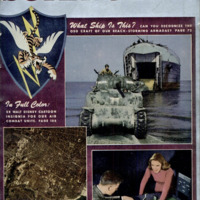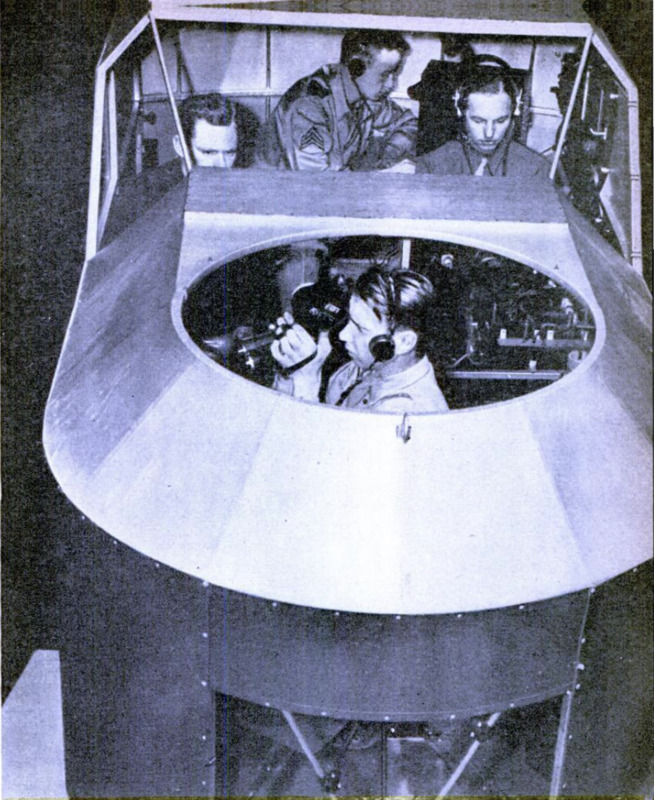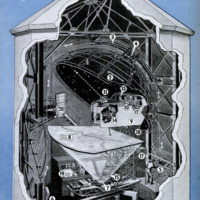-
Title (Dublin Core)
-
The celestial Navigation Trainer, a flight simulator for students
-
Article Title and/or Image Caption (Dublin Core)
-
Title: Bombing Tokyo from a silo
-
Subtitle: Even a veteran combat pilot gets a thrill out of flying a mission in the Air Force's magic carpet, The Celestial Navigation Trainer
-
extracted text (Extract Text)
-
THE other day, I took off in a four-
engine ship, maneuvered to altitude.
Crossing the Atlantic Ocean, Africa,
the Arabian Sea, India, Burma, and China, I
bombed Japan. After I saw my bombs blast
Tokyo, I could have flown on over Kam-
chatka, along the Aleutians to Alaska, then
home to Florida. After all this, though,
I climbed down the ladder from my ship and
~~
found that I had made a landing in a silo.
No, it wasn’t a dream. It actually hap-
pened—and I'll tell you how.
It began the other day, when I saw, for
the first time, several peculiar-looking build-
ings which rise from Florida's flat, sandy
terrain. They look just like the familiar
grain silos of our breadbasket cduntry of
the Middle West, or the friendly réd ele-
vators of Saskatchewan. They are about
40 feet high—cylindrical and with hemi-
spherical domes; you can see the domes
revolving. The whole thing looks like an observatory. Ac-
tually, it is the School of Applied Tactics of the Army Air
Forces—AAFSAT for short.
The first time I saw these strange-looking houses, I thought
we'd gone into the grain business, but when I strolled through
the open door of one I found an air-conditioned classroom.
The interior was light-sealed and, with the door closed, real
darkness pushed in on me. When the lights were turned on,
I saw the Celestial Navigation Trainer, a glorified Link
Trainer, rising frcm a heavy concrete base. High above,
supported by a tower on a revolving platform, was the
fuselage of the “plane.”
This fuselage, I found later, was attached to the top of the
column by a universal joint, which made possible the pitching
and banking of simulated flight. Beneath the airplane was a
screen, or terrain plate, which received the projected images
representing any part of the earth’s surface. I heard that
those scenes appeared as if actually viewed from an airplane
at 10,000 feet, but others could be projected with any altitude
desired. Images of clouds in any given density could be
thrown upon the same screen. Drift from anticipated cross
winds, or resultants of head winds or tail winds, could also
be introduced.
Above the ship, I saw the hemispherical dome, made of
chicken wire and holding the lights representing the stars
used for navigation. There were also the outlines of the
constellations. This dome could be rotated and moved on
machined rollers over the dome rail to simulate the passage
of time or the change in longitude and latitude. The axis of
the sphere, half of which was represented by the dome, fell
within the fuselage of the trainer, and thus, by using his
bubble sextant, the navigator could determine accurately
the altitudes of the collimated “stars.”
In a lighted booth, under the ship, was an operator's desk.
There I saw various switches and controls by which the at-
tendant moved the dome and terrain plate. He also controlled
the radio to introduce problems of actual flying; he could
even simulate two radio stations for obtaining bearings within
the ship. An automatic recording gadget traced the flight path.
The cockpit of the trainer was that of a four-engine bomber.
I entered with my crew—pilot, copilot, navigator, hombar-
dier, and radio operator—and we sat in our usual places for
a combat mission. As we started the engines, there came
the noise of real engines breaking into life, and I felt the
steady vibrations. Every instrument was on the dashboard.
Over the radio, the operator called, “All clear for take-off.” T
checked the fuel gauges and noted that they actually func-
tioned. I heard the operator call for the dome to be set for
our flight, and he turned on the time and navigation switches.
That set up a motion of the dome, corresponding exactly
to the change in the heavens visible to an observer moving
at the same speed and in the same direction as the simulated
flight of the trainer. A motor began to turn the dome from
east to west at a rate equal to the change in longitude. This,
of course, depended on the east-west course and the ground
speed. At the same time, the latitude drive moved the dome
up or down at a rate equal to the change in latitude caused by
the north-south course of the ship. Automatically, the dome
gear box compensated for the apparent motion, east or west,
of the stars.
Taking off in the silo, I had every sensation of flight, and
as I looked at the lighted projection in front of the wind-
shield, I saw the trees rushing back toward us—and I al-
most ducked as they went by, close
underneath, Now I saw the first navigation
chart projected on the screen. As the hours
dragged by to the steady drone of the
engines, I watched the fuel “simulatedly”
used up. With the help of my copilot, I
adjusted the throttle for best economy; we
had a long trip ahead. I set the turbos and
the manometers, and tuned in the radio fora
broadcast to pass the time. Later, I noted
that the local radio for Orlando, Fla., was
even made to fade. Then the operator tuned |
in on our first destination, Trinidad. The RDF
needle became more and more sensitive as
we approached South America. In seven |
hours, the coast of this continent, seemingly
coming out of the blue-green Caribbean, slid
under the ship on the screen. We had been
averaging 300 miles an hour and, as Port
of Spain went below, we even followed the
“military corridor of approach,” for this was
actual training for war. After landing at
Waller Field, we climbed down the ladder to
the ground, to wait while the ship was re-
serviced. Coffee would taste mighty good
now! After all, we'd really been in that
cockpit nearly eight hours. Stepping off the
ladder, we walked through the dim light |
to the open sunshine—the terrain looked
just as green as I expected Trinidad to ap- |
pear, but the pine trees looked too much like
Florida. I saw a couple of Wacs and then |
a Coca-Cola truck and began to come out of
my dreams.
As the days passed, I went on longer navi-
gation flights and finally came to Africa. |
All along that trip I'd look at the dark
heavens where the stars were “simulatedly”
covered with an overcast. The trackless
waste of darkness below could be the ocean
or the black jungle. Every now and then,
I'd hear a voice, “Okay, Joe, turn on the
stars,” and overhead would appear the
friendly collimated lights. I saw our navi- |
gator’s sextant light flash for a few seconds
as he shot our position. I could see the Big
Dipper almost on the horizon, and I knew
we were near the equator. Then I'd prove it |
by finding the Southern Cross, and I'd call |
“Corona Australis” to my navigator to show
him how smart I was. There would be
Cassiopeia and the Pleiades, too. Suddenly
a rude voice called out, “Turn out the stars,”
and overhead they flickered and went out.
It was dark as hell again, and lonesome.
Then there would be the steady drome of |
the engines as we pitched and tossed in a
man-made storm.
When daylight came and I could see the
screen, which was our world, I began to
tense, because the terrain was the approach
to Tokyo. As we made our corrections to
arrive over the initial point for the bombing
run, I heard the rude voice call out, “Turn
on the clouds.” Then quickly, part of the
earth was hidden and dark stratus clouds
drifted across the screen. Through a rift in
them, I saw the island that was our initial
point. I turned to the correct heading, and
there was the target ahead—I had studied
these landmarks so long on my maps that
they were familiar to me. I called my
bombardier on the interphone, “It’s all yours,
George. Take her away.” From there, he
would fly the ship to the target. The rude
voice now called, “Put in the wind drift,”
and the clouds seemed to drift crossways. I
knew then the operator was making it
tough. We now were approaching the target
with it lined up in the bombsight. I heard
and felt the bomb-bay doors opening, and
my heart beat faster. The ship lurched as
I involuntarily pulled back on the wheel.
‘When George called, “Bombs away,” I
took the controls away from the AFCE. It
seemed just like the time we had bombed
Rangoon. I looked out hurriedly into the
blankness of the cockpit windows, half ex-
pecting to see Zeros with their red-circled
insignia gleaming in the sun, but my eyes
met only darkness. As I gazed down at the
city of Tokyo, I ducked my head, for ack-ack
should have been bursting. Then I knew
that the only thing which the inventor had
missed was an automatic gadget down on
the floor to shoot a Very pistol or a Roman
candle at us while the operator fired a few
firecrackers.
Then the bombs struck! After the time
of fall had elapsed, there flashed on the
screen a little light which show their point
of impact. It was perfect! I actually
couldn't control myself—I yelled as loud as
1 could, for our bombs had scored a direct
hit on the Emperor's Palace!
The excitement has been too much for me;
I take evasive action for a few minutes on
the return flight anyway, but I'm just too
fagged out. I turn the ship over to the
younger copilot, who didn’t see it all, and
try to get my nerves settled.
Even after I open the silo door and walk
out into the sunshine of Florida, it's going
to be hard to settle down to an ordinary ex-
istence again. I'm going right down town
and buy a local newspaper, for two reasons:
First, IT want to see what town I'm actually
in; and second, I went to see if Tokyo wasn't
bombed today by a four-engine bomber.
-
Contributor (Dublin Core)
-
Robert L. Scott Jr. (article writer)
-
Stewart Rouse (illustrator)
-
Language (Dublin Core)
-
eng
-
Date Issued (Dublin Core)
-
1944-04
-
pages (Bibliographic Ontology)
-
57-59, 198
-
Rights (Dublin Core)
-
Public Domain (Google digitized)
-
Archived by (Dublin Core)
-
Lorenzo Chinellato
-
Marco Bortolami (editor)
 Popular Science Monthly, v. 144, n. 4, 1944
Popular Science Monthly, v. 144, n. 4, 1944




